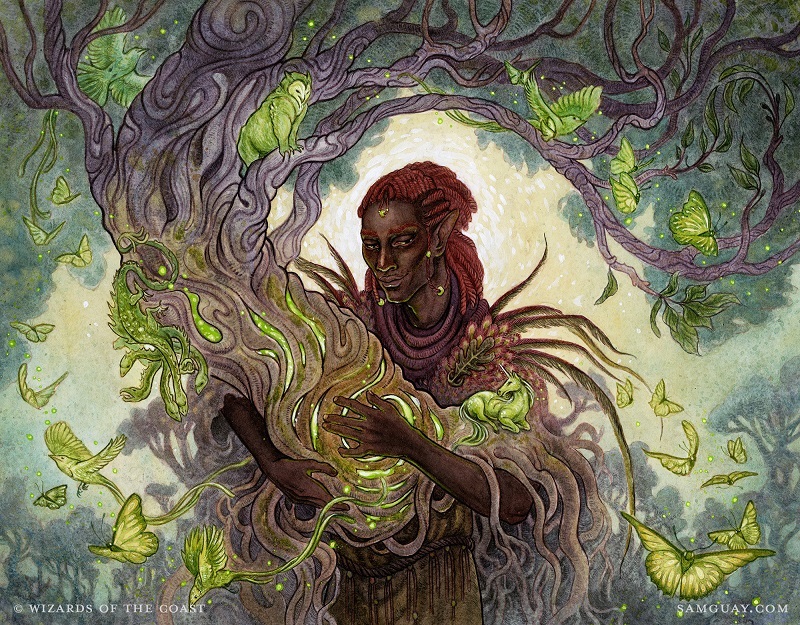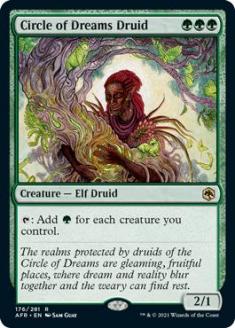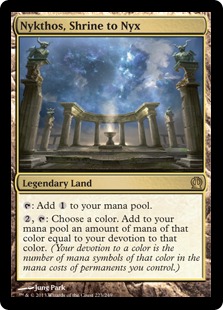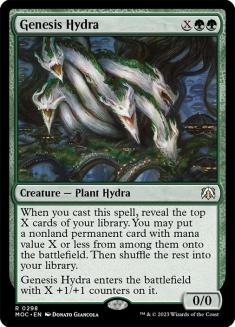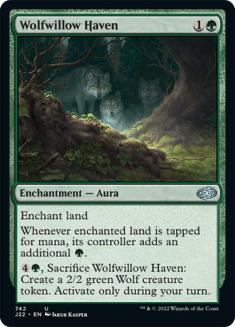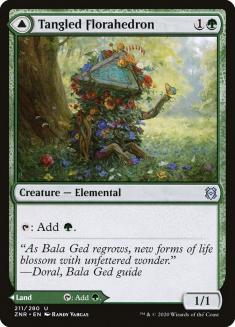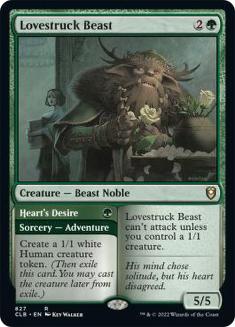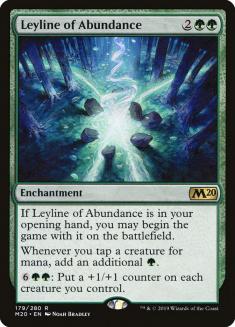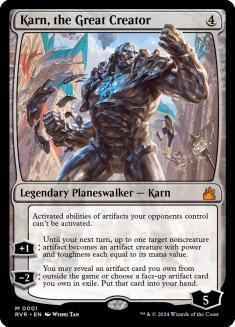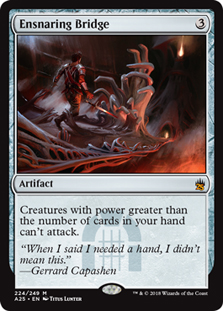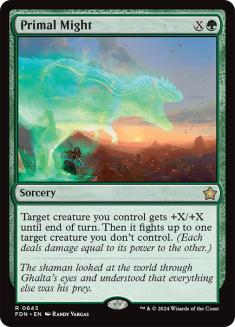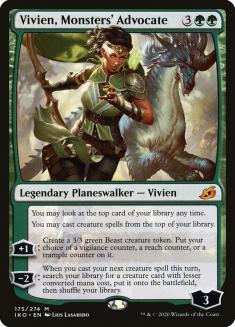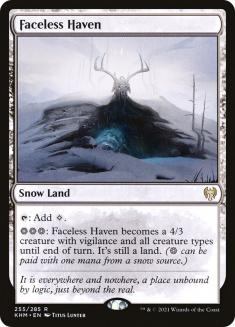Throughout my time playing Magic, little gives me greater joy than playing a creature that generates mana. From Llanowar Elves to Lotus Guardian, I like ramping and I like going big. Bigger. Bigger than that. Yeah, even a little bigger than that.
Circle of Dreams Druid is the newest tool for pushing the limits of what we can do with mana generating creatures. For anyone who’s ever played with Gaea’s Cradle before, you know just how absurd it can be when paired with a host of smaller creatures. In Legacy specifically, the decks that play Gaea’s Cradle are often flush with cheap creatures. By flooding the battlefield, you create more mana which then lets you cast bigger and better stuff as the game progresses. In Cube, I take Gaea’s Cradle pretty highly because there are few things I want to do more than Genesis Wave for my entire deck.
This being a three-drop creature means we want to pair it with other one-mana creatures that help accelerate into it as quickly as possible. If we can get this down on the second turn, our third and fourth turns will be ripe with potential as long as our Circle of Creams Druid survives. Should our opponent kill our early stuff to slow us down, Circle of Dreams Druid can still tap for at least one mana on its own, yet will provide us with extra just for casting some creatures before tapping it. If you’ve ever played with Elvish Archdruid before, the patterns are similar. You want to cast a few creatures before tapping it so you get as much mana as possible.
Because of how Circle of Dreams Druid plays out, it’s much easier to pair it with cards that have variable casting costs. We like ways to sink our mana when we have a ton, but drawing big dummies that we can’t cast without six or seven mana is a dangerous way to build. In essence, we want a lot of Walking Ballista equivalents and not very many of Ulamog, the Ceaseless Hunger. Big spells that get better when you have more mana but are still castable with less mana are how you go from “fun” to “competitive.”
In Pioneer
The three green pips on the casting cost actually make it desirable with another of my favorite cards, which just so happens to produce a billion mana.
In Pioneer specifically, Nykthos, Shrine to Nyx is one of the most powerful cards because the green cards surrounding it help create a perfect storm of mana and outlets for spending that mana. Vivien, Arkbow Ranger is one of the best tools because it gives so many pips for Nykthos, adds some versatility in interaction, and provides us with a way to find Ulamog without actually having to draw it or put it into our deck.
Nykthos is a great way to generate mana in the middle of the game, but the nightmare scenarios for the opponent usually involve Burning-Tree Emissary and using it to gain mana very quickly. The downside to Nykthos is that it’s legendary and doesn’t tap for colored mana until you have three pips on the battlefield. Playing four copies of Nykthos can make it tough to cast cards that have triple pips in the casting cost, because you have a hard time getting it onto the battlefield in the first place when your land is tapping for colorless.
In practice, it isn’t that hard to play them both together because you can usually find a third colored source to get it onto the battlefield, or enough pips early to use Nykthos for three colored mana, or else it’s just powerful enough with the three extra pips to be worth that minor inconvenience.
So now we have a land and a creature that both produce an enormous amount of mana. Let’s put them together and see what we can do in Pioneer!
Creatures (28)
- 4 Llanowar Elves
- 4 Burning-Tree Emissary
- 4 Elvish Mystic
- 4 Genesis Hydra
- 4 Voracious Hydra
- 4 Tangled Florahedron
- 4 Circle of Dreams Druid
Planeswalkers (8)
Lands (20)
Spells (4)

Genesis Hydra is a nod to our ability to generate a ton of extra mana, but also wanting more raw bodies on the battlefield. An early Genesis Hydra for two or three can hit an additional creature, giving us more mana with Circle of Dreams Druid. As the game progresses, Genesis Hydra can be powered by Circle of Dreams Druid to find our big planeswalkers like Nissa, Who Shakes the World and Vivien, Arkbow Ranger.
I’ve moved away from Wolfwillow Haven because it doesn’t help generate extra mana with Circle of Dreams Druid, and I have not found another creature I like in this shell in the two-drop slot other than Tangled Florahedron. I like the ability to play the mana creatures as lands to help smooth our draws or give us a bit of a burst when we have too many lands. In the long run, it might be correct to play Wolfwillow Haven even if you’re playing Circle of Dreams Druid, but I wanted to give the Druid a chance to shine before I went back to “stock.”
Lovestruck Beast is a nod to Circle of Dreams Druid in order to generate a few extra bodies. It has regularly been a sideboard option for me, as I love moving into more robust creatures when my opponent will have sweepers or more spot removal. Lovestruck Beast is particularly good at playing defense agaisnt red decks, and dodges most red removal. In the maindeck, you have eight Elves to continue enabling it, even if they end up knocking off your 1/1 token.
The extra pressure added by playing Lovestruck Beast means we can also get a little more aggressive with Vivien, Arkbow Ranger after sideboard. Having a large body to use the minus and kill opposing large creatures is pretty sweet, but the ability to give it trample and a +1/+1 counter is rad.
In Modern
Modern’s green deck that will want to utilize Circle of Dreams Druid might not exactly be mainstream, but there’s a chance this addition helps push it to the forefront. There have been some successful brews in Modern that use Nykthos, Shrine to Nyx and a bunch of cheap creatures. Elves decks also already have access to Elvish Archdruid, which does more for the deck than Circle of Dreams Druid. In order to get max value, we need to play creatures that aren’t Elves.
Creatures (21)
- 1 Llanowar Elves
- 4 Birds of Paradise
- 4 Noble Hierarch
- 4 Burning-Tree Emissary
- 1 Elvish Mystic
- 3 Walking Ballista
- 4 Circle of Dreams Druid
Planeswalkers (10)
Lands (21)
Spells (8)
Sideboard

They banned Leyline of Abundance in Pioneer pretty quickly, so my experience with it has been mostly testing brews in Modern. What I’ve found is that having a card that helps you produce extra mana while also providing you a mana sink is invaluable. I’ve won so many games by just casting a bunch of mana creatures and using the extra mana I’m generating to make my Birds of Paradise into more of a pterodactyl. I’m hoping that Circle of Dreams Druid will help give me enough mana to overpower opponents who aren’t being overly interactive. Leyline of Abundance helps in that plan, but also gives me a way to use that extra mana when I don’t draw one of my payoffs, or that payoff is discarded, killed, or countered.
Karn, the Great Creator is an absurd spell in a deck whose only goal is to produce a large amount of mana. If we have access to a plethora of mana, Karn is one of our best draws. We can find and cast a card in the same turn, which means we get to lay the hammer down on a lot of different archetypes with a single hate card. When you have time to set up, grabbing Walking Ballista could just end the game by dealing your opponent sixteen or more damage.
Since one of our main win conditions is Walking Ballista, the sideboard Ensnaring Bridge is a hefty bullet to grab with Karn. It’s a way to steal games from some opponents who might not have an answer.
In Standard
Standard is the format where Circle of Dreams Druid could really spark a new archetype. Depending on the direction and amount of interaction, having a relatively cheap creature that generates a ton of mana can be frightening to play against. Again, the X-factor will be finding the right combination of cards that are good in the mid- and late-game; we’re looking for cards that scale with more mana. Luckily, there’s been one card that has become an all-time favorite of mine over the last year.
I’ve seen Primal Might do some dirty things. A few years back, I noticed how easy it was to fight something without getting punished. Cards like Hunt the Hunter and Vivien, Arkbow Ranger always connected. Primal Might started to see some play shortly after, and it was excellent. As we put more mana into it, it only gets better. If you tap Circle of Dreams Druid to power it up, you might just send your opponent into space.
Creatures (29)
- 1 Scavenging Ooze
- 4 Gilded Goose
- 4 Lovestruck Beast
- 4 Stonecoil Serpent
- 4 Gemrazer
- 4 Tangled Florahedron
- 4 Kazandu Mammoth
- 4 Circle of Dreams Druid
Planeswalkers (3)
Lands (21)
Spells (7)

I’ve found that one of the easiest ways for The Great Henge decks to lose is because it gets stuck in your hand. If your opponent is killing all your big creatures, it might make things difficult as far as casting The Great Henge. We can overcome this by playing more big creatures or trying to sidestep it via generating a ton of mana with Circle of Dreams Druid.
One bottleneck for decks that generate a lot of mana is not having enough things to do with that mana. Vivien, Monsters’ Advocate gives us a way to play cards from the top of our deck, meaning we can use the mana as long as the top of our deck has creatures on top of it. It’s also a fine card to curve into against an opponent who’s trying to weather you down via attrition.
One big loss is Faceless Haven, which can’t really help cast Circle of Dreams Druid. I’m not sure how I feel about this yet, as the two cards are at odds with each other. Triple green is just a bit too restrictive.
Gilded Goose provides this deck with two things it desperately needs: more creatures and a way to cast Circle of Dreams Druid on the second turn. Not a lot of the green beatdown decks have been playing Gilded Goose because the one shot of mana just wasn’t worth it. However, I think the extra body and fast ramp make it worth it for Circle of Dreams Druid alone. We also get the nut draw of Goose into Tangled Florahedron into Vivien, Monsters’ Advocate when we’re on the play. Not quite as impressive as Nissa, Who Shakes the World to be clear, but still great in a number of matchups.
Dungeons, Dragons, and Druids
I think Pioneer is probably going to be the best home for Circle of Dreams Druid. It working with Nykthos and already having a powerful home to “do its thang” is pretty sick. I’m always a fan of cards that are looking to go absolutely bonkers if your opponent doesn’t interact with you. “Gaea’s Cradle but a creature” is not something I knew I wanted until now, but I’m glad it exists and glad I get to try it out soon.
I think Pioneer is the place it will shine specifically because it’s already the best home for Nykthos, and all of your goals intersect. You don’t care about having beefy creatures or doing anything specific outside of generating tons of mana and finding little ways to use that mana. Your big planeswalkers might be the best way to use that mana, and I might be making a big mistake by not including Karn, the Great Creator. It’s all just theorycrafting right now, and I’m sure I’ll be brewing all sorts of stuff when the card is finally released in a few weeks.
I’ve been having a lot of fun with Magic lately. The new set, Dungeons & Dragons: Adventures in the Forgotten Realms, seems to be keeping the word “fun” in mind with a lot of their new cards and mechanics. A lot of spells have multiple uses, meaning you’ll have more dynamic gameplay featuring the same game pieces. The Dungeon mechanic seems flavorful and interesting.
On the whole, I’m seeing a lot to like, so I’m pumped to see what comes next.

